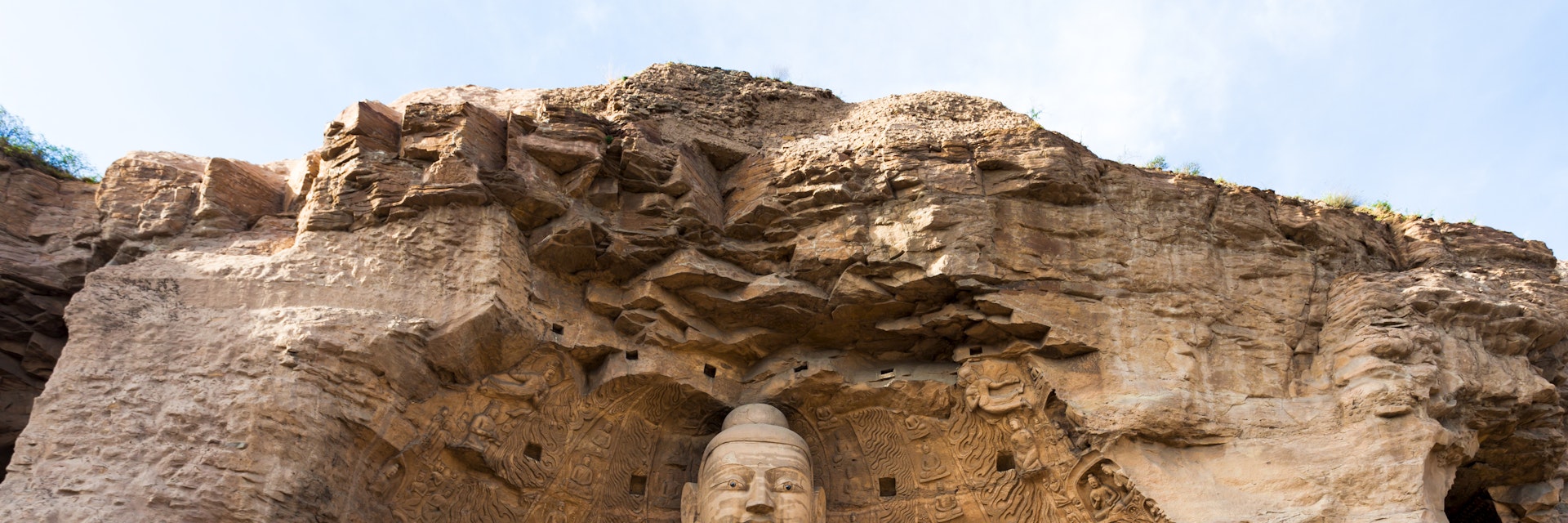One of China’s most supreme examples of Buddhist cave art, these 5th-century caves are simply magnificent. With 51,000 ancient statues and celestial beings, they put virtually everything else in the Shanxi shade. Carved by the Turkic-speaking Tuoba, the Yungang Caves drew their designs from Indian, Persian and even Greek influences that swept along the Silk Road. Work began in AD 460, continuing for 60 years before all 252 caves, the oldest collection of Buddhist carvings in China, had been completed.
Pass through the visitors centre and a recreated temple on a lake before arriving at the caves. You may find some caves shut for restoration and this is done on a rotational basis. Despite weathering, many of the statues at Yungang still retain their gorgeous pigment. The caves that are deeply recessed, in particular, have been well protected from the outside weather, although the penetration of water from above is a constant hazard.
A number of caves were once covered by wooden structures. Many of these are long gone, although the very impressive Caves 5 to 13 are still fronted by recently constructed wooden temples.
Some caves contain intricately carved square-shaped pagodas or central columns which you can circumambulate, while others depict the inside of temples, carved and painted to look as though they're made of wood. Frescoes are in abundance and there are graceful depictions of animals, birds and angels, some still brightly painted, and almost every cave contains the 1000-Buddha motif (tiny Buddhas seated in niches).
Eight of the caves contain enormous Buddha statues; the largest can be found in Cave 5, an outstanding 17m-high, seated effigy of Sakyamuni with a gilded face. As with many here, the frescoes in this cave are badly scratched and vandalised, but note the painted vaulted ceiling. Bursting with colour, Cave 6, the Cave of Sakyamuni, is also stunning, resembling an overblown set from an Indiana Jones epic with legions of Buddhist angels, Bodhisattvas and other celestial figures. In the middle of the cave, a square block pagoda or column fuses with the ceiling, with Buddhas on each side across two levels. Most foreign visitors are oblivious to the graffiti in bright red oil paint on the right-hand side of the main door frame within the cave, which reads 大同八中 (Dàtóng Bāzhōng, Datong No 8 Middle School), probably courtesy of pupils during the Cultural Revolution. The frescoes here are also badly scratched by recent visitors from the years of turmoil – the 50-year-old date '76.12.8' is etched crudely.
The dual chamber Cave 9, the Aksokhya Buddha Cave, is an astonishing spectacle too, with its vast seated and gold-faced Buddha.
Caves 16 to 20 are the earliest caves at Yungang, carved under the supervision of monk Tanyao. Cave 16, the Standing Buddha Cave, contains a huge standing Buddha whose middle section is badly eroded. The walls of the cave are perforated with small niches containing Buddhas. Cave 17 houses a colossal 15.6m seated Maitreya Buddha, badly weathered, but intact. Examine the exceptional quality of the carvings in Cave 18; some of the faces are perfectly presented. Cave 19 contains a vast 16.8m-high effigy of Sakyamuni.
Entirely exposed to the elements, Cave 20 (AD 460–470) originally depicts a trinity of Buddhas (the past, present and future Buddhas). The huge seated Buddha in the middle is the representative icon at Yungang, while the Buddha on the left has somehow vanished. Prayer mats are arrayed out front so that pilgrims can worship.
Past the last set of caves, you can turn off the path down to the slick and informative museum (9.30am to 4.30pm) detailing the Wei Kingdom and the artwork at the caves. English captions are limited.
Most of the caves, however, come with good dual Chinese/English captions. English-speaking tour guides can be hired for ¥150; their services include a trip to the museum. Note that photography is permitted in some caves but not in others.
To get to the caves, take bus 603 (¥3, 45 minutes) from Datong train station to the terminus. Buses run every 15 minutes. A taxi from Datong is around ¥40 each way. You will pass the rather less appealing but interesting Datong Coal Mine en route.

